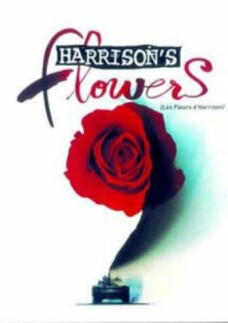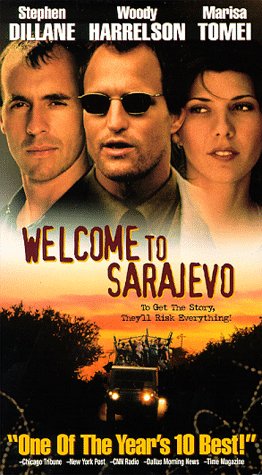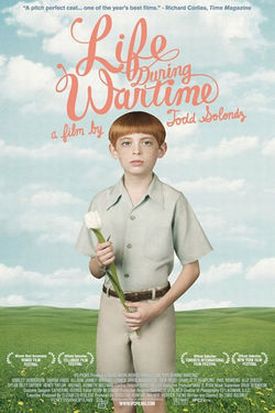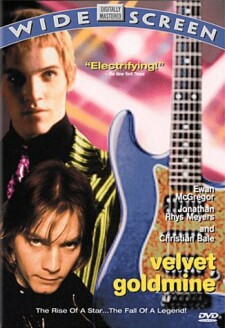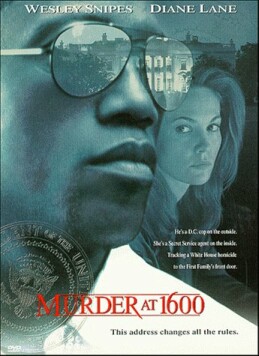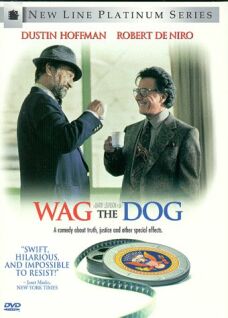Harrison’s Flowers
Interestingly, the main thing that is wrong with Harrison’s
Flowers — a sort of reverse Orpheus story with a happy ending,
made in English (with a bit of Serbo-Croat) by the French director, Elie
Chouraqui — is also, probably inadvertently, its subject. That is, it is a
movie at least in part about the appetite for information of our culture, and in
particular pictorial information, and the lengths to which people will go to get
it, even to the point of risking their lives. Or sending a swaggering bunch of
élite war-photographers off to risk theirs. Yet because so many people
have gone to such lengths for so long before it was ever made, the movie itself
has a tired, been-there, done-that feel to it.
Harrison Lloyd (David Strathairn) is a war photographer for Newsweek
who is sent to Bosnia in 1991, right at the beginning of the civil war, even
though we hear him tell his boss, Sam (Alun Armstrong) that he is apprehensive.
“It’s like my luck bank is down to zero,” he says. “I wasn’t
afraid of anything, but all I can think about now is Sarah and the kids. And I’m
sick of it.” Oh-oh. Have you seen enough movies to have some inkling of
what is about to happen? Of course the editor doesn’t know how bad the
Bosnian situation is going to get. He thinks it is “just ethnic
skirmishes” in these early stages. “The Europeans haven’t moved, and
it’s right in their own back yard. They know what they’re doing, don’t
they?” Surely Harrison will go just this one more time.
Such heavy-handed manipulations of dramatic irony are not untypical and only
serve to remind us that, if reality is unpredictable, movies are not. As soon as
we hear Harrison’s doubt and his editor’s confidence, we know
something bad is going to happen. When it does and he is reported killed, his
wife, Sarah (Andie MacDowell), refuses to believe the report of his death.
“He’s not dead, Sam. Something would have broken inside if he were
dead.” And she leaves her two small children and sets off for the Bosnian
hell-hole to find him. Once again, it ought not to be giving away any secret to
say that, of course, she finds him alive, though badly injured and not in his
right mind on account of a nearby bomb-blast. She brings him home and nurses him
back to health.
People often criticize critics who give away the ending, but most often it is
the movies themselves who give away their endings. In this case, it is
inconceivable that the devoted wife who refuses to believe the reports of her
husband’s death should not find him alive. Indeed, if she had not
done so, or if the most likely real-world eventuality had happened to her
instead of the most likely movie-world one and she had been killed, we would
have thought her not the heroine she obviously has to be but a fool to have made
orphans of her two small children for the sake of such a wild goose chase. But
her success and its disappointing quality are both artefacts of the medium, of
the number of pictures we have all consumed. In the same way, as soon as a
mission popped up on the opening, self-destructing tape of “Mission
Impossible” you knew that it was not only not impossible: it was
inevitable, a sure-fire success.
We are much too familiar with contemporary narrative conventions, therefore,
for a story like the one told in Harrison’s Flowers to work qua
story. It can only work, post-modern fashion, with a director or writer who
— alas, unlike Mr. Chouraqui — deliberately sets out to subvert
those conventions and so to give us a much-needed surprise. This is a pity. We
still need the old-fashioned stories. But they have been overwhelmed by the same
tidal wave of information on which Harrison and his fellow war photographers are
attempting to surf and on which some of them are sure to die. Pictures have
become a commodity, like gold or diamonds or coal used to be, for which men (and
women, of course) are prepared to risk their lives.
Not surprisingly, much is made of the high idealism which is supposed to
motivate their pursuit. “They know that our photos are going to tell the
story of this war. That’s why we’re here. If we don’t take ‘em, nobody
will,” says Kyle (Adrien Brody), Harrison’s bad-boy colleague. But
the evidence of war crimes that they turn up is just an added, celebrity-making
bonus for those whose papers are paying them top dollar not in order to save
lives or to bring war criminals to justice but to get a mass-audience with an
increasingly exigent addiction to voyeurism to buy their magazines or newspapers
or watch their TV network. Any pictures of war and its victims are valuable — though only, like fish (another commodity for which men risk their lives), so long as they are fresh.
Like war movies, or journalist movies for that matter, there are certain
built-in clichés of war photography. Another of Harrison’s
colleagues, Yaeger Pollock (Elias Koteas) says at an awards ceremony that
“photographs comprise the communal memory of our time,” but it is a
very special kind of memory — not, that is, the memory of any actual
community (though it may be that too) but of the global village looking on out
of morbid curiosity at the unfortunates of the world. The news
photographer’s very business is taking images out of context and so
distorting their meaning. They may perform valuable services in doing this, as
when they alert the world to war crimes or genocide in progress, but for the
most part they are as much traffickers in cliché as Mr Chouraqui.
And some of these clichés are particularly unfortunate, as, for
example that of war as the kind of random carnage that war photography (and most
war movies for the past 30 years or so) almost inevitably represents it as
being. “They’re all insane, Harrison,” says another of the
gallant photographers of the Serbs and the Bosnians. Except, of course, that
they are not. As a result, we have no sense at all of what the war was about,
nor are we meant to have. All we know for sure is that the Serbs are very bad
guys, a point seemingly in need of considerable reiteration. “Serb
Catholic Croatian Orthodox there’s no bad guys,” says Kyle. “They
are f****** insane.” Also in the cliché department is the amount of
trite and bogus attention given to Kyle’s resentment at big magazine
photographers and the whole business of a busy dad who needs to “spend
time with his family.” And what is with the flowers? Harrison’s
greenhouse, his hobby, supposed to be symbol of home, beauty, delicacy and
fragility, all that war shatters. I guess. Well sure. Never thought of it that
way before, did you? Another cliché. Another banality.
Discover more from James Bowman
Subscribe to get the latest posts to your email.

